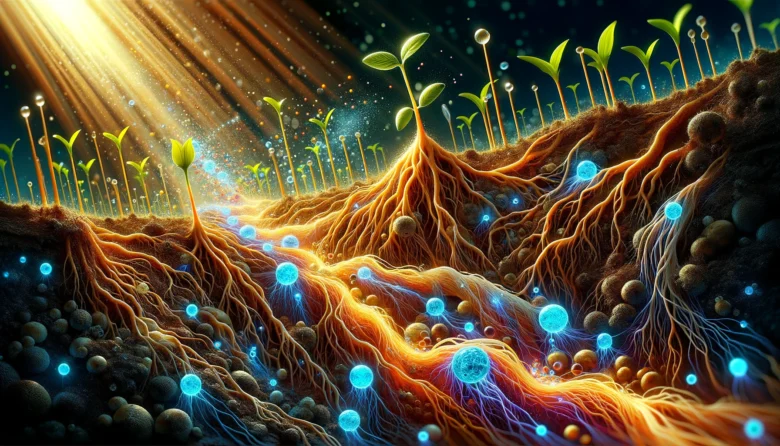Welcome to the first blog of our series – “Fungi & Soil: The Climate Change Combatants”
Diving deep into the natural world’s secrets to combat climate change, ‘Eco-Fungi: Earth’s Climate Fix’ unveils the remarkable potential of fungi in our quest for environmental solutions. Today, we’re going beneath the surface, quite literally, to explore a hidden kingdom that plays a pivotal role in our planet’s health and future. This realm, invisible to the naked eye yet colossal in its impact, is the domain of fungi. These organisms are not just a fascinating subject for scientists; they are our underground allies in the fight against global warming.
In this installment, we will uncover the intricate dance between fungi and soil organic carbon (SOC) sequestration, revealing how these tiny organisms are major players in mitigating climate change. Join us as we delve into the world of fungi and discover their crucial role in storing carbon deep within the earth, showcasing nature’s ingenuity and offering hope for a more sustainable future.

Fungi: Nature’s Carbon Capturers
Fungi are among the most incredible and versatile organisms on our planet, yet their vital role in ecological balance and climate mitigation often goes unnoticed. Acting as nature’s master recyclers, fungi decompose organic matter, returning essential nutrients to the soil and supporting new life. However, their role extends far beyond decomposition. Fungi are instrumental in sequestering carbon, a process critically important for reducing the atmospheric concentration of carbon dioxide (CO2), a major greenhouse gas contributing to climate change.
The Symbiotic Superpower
At the heart of fungi’s ability to capture carbon lies their symbiotic relationship with plants. Mycorrhizal fungi, in particular, form partnerships with the roots of most plant species. This relationship is a two-way street: plants provide fungi with carbohydrates produced through photosynthesis, and in return, fungi enhance the plant’s uptake of water and nutrients. This exchange is not just beneficial for plant growth and fungal nourishment; it is a crucial mechanism for carbon sequestration.

When plants absorb CO2 from the atmosphere, they convert it into organic compounds to fuel their growth. A portion of this carbon is transferred to the fungi, which then transport it into the soil. Once in the soil, this carbon is incorporated into fungal biomass or binds with soil minerals, effectively removing it from the atmospheric cycle and storing it underground. This process is a natural form of carbon capture and storage that plays a significant role in mitigating the effects of climate change.
The Impact on Climate Change
The intricate work of fungi in sequestering carbon plays a transformative role in combating climate change. By capturing carbon dioxide—a key player among greenhouse gases—fungi act as a natural buffer against global warming. This process is not just about removing carbon from the atmosphere; it’s about transforming it into a stable form that can remain locked away in the soil for centuries if not millennia. This hidden mechanism is a testament to nature’s resilience and ingenuity, offering a beacon of hope in our fight against climate change.

As we grapple with the need to reduce atmospheric CO2 levels, the role of fungi becomes increasingly significant. Their ability to sequester carbon helps decrease the overall concentration of greenhouse gases, slowing the pace of global warming and giving ecosystems a fighting chance to adapt. This natural form of carbon capture and storage is a crucial piece of the puzzle in our broader climate mitigation strategies, showcasing how biodiversity and ecosystem health are directly tied to our climate resilience.
Fungi and Sustainable Farming
Sustainable farming practices serve as a vital link between fungi and their capacity to combat climate change through carbon sequestration. By adopting methods that support the health and proliferation of fungal networks, farmers can enhance the soil’s carbon storage potential. Practices such as minimal tillage, cover cropping, and organic farming not only preserve soil integrity but also encourage the growth of mycorrhizal fungi. These practices create a conducive environment for fungi to thrive, facilitating their crucial work of carbon transfer and storage.

In essence, sustainable farming practices recognize the symbiotic relationship between plants, fungi, and the soil. By maintaining a healthy soil ecosystem, we can significantly boost the soil’s capacity to act as a carbon sink. This not only benefits the environment by mitigating the effects of climate change but also supports agricultural productivity and resilience. As we move towards more sustainable agricultural models, the role of fungi in enhancing soil health and carbon sequestration becomes a cornerstone of ecological farming and climate-smart agriculture.
The Power of Mycelium
The mycelium, often referred to as nature’s internet, is the driving force behind the soil’s capacity to sequester carbon. This vast and intricate network of fungal filaments forms the foundation of the soil ecosystem, connecting individual plants and facilitating the exchange of nutrients and carbon. The mycelium’s extensive reach and high surface area make it exceptionally efficient at absorbing carbon from plant roots and redistributing it within the soil.

Moreover, the mycelium strengthens soil structure, which is crucial for carbon storage. By binding soil particles together, it creates stable aggregates that protect organic carbon from decomposition. This not only helps in storing carbon more effectively but also improves soil fertility, water retention, and resistance to erosion. The mycelium’s role in enhancing soil stability and health underscores its importance in ecosystem functioning and climate change mitigation.
Through their unseen yet profound influence on soil health and carbon dynamics, fungi, powered by their mycelial networks, emerge as unsung heroes in our quest for sustainable solutions to climate change. Their ability to sequester carbon, support sustainable agriculture, and maintain ecosystem resilience highlights the interconnectedness of life and the pivotal role of biodiversity in addressing global challenges.
Author’s Note
As we delve deeper into the symbiotic world of fungi and plants, it’s clear that these organisms are not just surviving; they are thriving by helping the planet combat climate change. Through this blog, we hope to shed light on the unseen efforts of fungi in enriching our soil and safeguarding our environment. Join us as we continue to explore the pivotal roles these microscopic yet mighty organisms play in our ecosystem.
G.C., Ecosociosphere contributor.
References and Further Reading
- “The Hidden Half of Nature: The Microbial Roots of Life and Health” by David R. Montgomery and Anne Biklé – Explore the unseen connections between microbial life, plants, and human health.
- “Mycelium Running: How Mushrooms Can Help Save the World” by Paul Stamets – Delve into the fascinating world of fungi and their potential to solve environmental problems.
- “Dirt: The Erosion of Civilizations” by David R. Montgomery – Understand the crucial role of soil in human history and its potential future impact.
Stay tuned for our next blog, where we’ll explore the incredible world of biochar and its environmental benefits, another key area where fungi are making a difference in our fight against climate change.





Comments
I don’t think the title of your article matches the content lol. Just kidding, mainly because I had some doubts after reading the article.
I don’t think the title of your article matches the content lol. Just kidding, mainly because I had some doubts after reading the article.
Can you be more specific about the content of your article? After reading it, I still have some doubts. Hope you can help me.